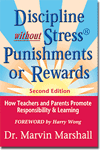|
 |
| Teachers.Net Gazette Vol.6 No.7 | July 2009 |
Subscribe for free home delivery |
|
Using Imaging to Move or Change Behavior The images in our minds drive our behaviors. The body literally cannot move contrary to a vividly held image. Therefore, in order to change a habit or behavior, we must change our perception to include the new habit or behavior. | |
| by Dr. Marvin Marshall www.MarvinMarshall.com Regular contributor to the Gazette July 1, 2009 |
|
|
 The images in our minds drive our behaviors.The opening paragraph of my book deals with mindsets. It sets the stage for the entire book because my purpose is to influence young people to have mindsets where they WANT to be responsible and WANT to learn. The objective is to create visual images that drive behaviors. The following exercise (shared with me by Jack Canfield, coauthor with Mark Victor Hansen of “The Aladdin Factor” and the “Chicken Soup” series) gives students an experience of the power of imagery for both behavior and learning. Students will need room for the exercise. Divide the class in two groups, A and B. Say the following to group A: I want you to close your eyes and imagine in your mind a seagull floating gracefully in the air. See it gently, easily, effortlessly gliding through the air. When you have the picture of a seagull vividly in your mind, nod your head. Now with your eyes a quarter of the way open so that you can see the floor in front of you and have a sense of where your neighbors are, move like a seagull—keeping the image of the seagull vividly in your mind. Continue that while I go over to the other group. Say the following to group B: Close your eyes and imagine a jackhammer. See it moving rapidly up and down in short, jerky, staccato movements. When you have that picture of a jackhammer vividly in your mind, nod your head. Now with your eyes a quarter of the way open so that you can see the floor in front of you and have a sense of where your neighbors are, move like a jackhammer—keeping the image of the jackhammer vividly in your mind. Continue that while I go over to the other group. Turn back to group A and continue: Once again, close your eyes and imagine that effortless, graceful seagull floating on an air current, barely moving its wings. When you have that picture vividly in your mind, nod your head. Now keeping that image of the seagull vividly in your mind, open your eyes a quarter of the way and move like a jackhammer. Most students will have a great deal of difficulty moving like jackhammers while thinking of a seagull. Their movements will be somewhere in between jerky and graceful, or they will be frozen and unable to move at all. Turn to group B and say: Close your eyes again, and imagine that jerky jackhammer bouncing up and down on the pavement. When you have that picture vividly in your mind, nod your head. Now while keeping the image of the jackhammer vividly in your mind, open your eyes a quarter of the way and move gracefully like a seagull. Again, students will have a tough time making their bodies move counter to the image they are holding in their heads. This is a very dramatic exercise—one that easily and quickly makes the point that our bodies cannot do anything counter to the images we hold in our minds. Have the students share anything they noticed about their bodies the second time when they were holding an image counter to how they were trying to move. If any student claims that it was easy to move the second time, ask if both images were equally visualized. Most will admit that they had to let go of one image in order to move like the other image. Ask them if a friend has ever asked them to do something unusual, and they responded, “I couldn’t do that; it’s not me.” The reason we say that is because we look inside our minds and see if what our friend has asked us to do fits our perception of ourselves. If it doesn’t fit, we don’t think we can do it; so we don’t even attempt it. Emphasize the following point: The body literally cannot move contrary to a vividly held image. Therefore, in order to change a habit or behavior, we must change our perception to include the new habit or behavior. Otherwise, any changes we make will be difficult and short-lived. Subscribe to the free, monthly newsletter "Promoting Responsibility and Learning" at MarvinMarshall.com. Copyright © 2009 Marvin Marshall.
Any school in the USA can receive free “Discipline Without Stress” books by completing the application at DisciplineWithoutStress.org | |
|
 You can make up all the checklists you want. You can take advice from your mentors. At the end of the day, what lies behind one's teaching style is what matters. A "Great Teacher" is the right teacher at the right time, at the right place.
You can make up all the checklists you want. You can take advice from your mentors. At the end of the day, what lies behind one's teaching style is what matters. A "Great Teacher" is the right teacher at the right time, at the right place.

 His approach is the only system that is proactive, totally noncoercive, and does not use external manipulatives or threats. He INDUCES students to WANT to act responsibly and WANT to put forth effort to learn.
His approach is the only system that is proactive, totally noncoercive, and does not use external manipulatives or threats. He INDUCES students to WANT to act responsibly and WANT to put forth effort to learn.
